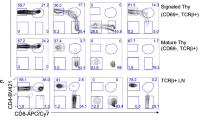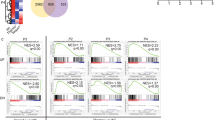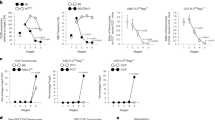Abstract
The duration of T cell receptor (TCR) signaling is thought to be important for thymocyte differentiation into the CD4 or CD8 lineage. However, the in vivo relevance of this hypothesis is unclear. Here we divided T cell positive selection into genetically separable developmental steps by confining TCR signal transduction to discrete thymocyte developmental windows. TCR signals confined to the double-positive thymocyte stage promoted CD8, but not CD4, lineage differentiation. Major histocompatibility complex (MHC) class II–restricted thymocytes were, instead, redirected into the CD8 lineage. These findings support the hypothesis that distinct kinetics of MHC class I– and MHC class II–induced TCR signals direct intrathymic developmental decisions.
This is a preview of subscription content, access via your institution
Access options
Subscribe to this journal
Receive 12 print issues and online access
$209.00 per year
only $17.42 per issue
Buy this article
- Purchase on Springer Link
- Instant access to full article PDF
Prices may be subject to local taxes which are calculated during checkout






Similar content being viewed by others
References
Janeway, C.A.J. & Bottomly, K. Signals and signs for lymphocyte responses. Cell 76, 275–285 (1994).
Weiss, A. & Littman, D.R. Signal transduction by lymphocyte antigen receptors. Cell 76, 263–274 (1994).
Kisielow, P. & von Boehmer, H. Development and selection of T cells: facts and puzzles. Adv. Immunol. 58, 87–209 (1995).
Taniuchi, I. et al. Differential requirements for Runx proteins in CD4 repression and epigenetic silencing during T lymphocyte development. Cell 111, 621–633 (2002).
Hogquist, K.A. Signal strength in thymic selection and lineage commitment. Curr. Opin. Immunol. 13, 225–231 (2001).
Singer, A. New perspectives on a developmental dilemma: the kinetic signaling model and the importance of signal duration for the CD4/CD8 lineage decision. Curr. Opin. Immunol. 14, 207–215 (2002).
Germain, R.N. T-cell development and the CD4-CD8 lineage decision. Nat. Rev. Immunol. 2, 309–322 (2002).
Itano, A. et al. The cytoplasmic domain of CD4 promotes the development of CD4 lineage T cells. J. Exp. Med. 183, 731–741 (1996).
Matechak, E.O., Killeen, N., Hedrick, S.M. & Fowlkes, B.J. MHC class II-specific T cells can develop in the CD8 lineage when CD4 is absent. Immunity 4, 337–347 (1996).
Sharp, L.L., Schwarz, D.A., Bott, C.M., Marshall, C.J. & Hedrick, S.M. The influence of the MAPK pathway on T cell lineage commitment. Immunity 7, 609–618 (1997).
Bommhardt, U., Cole, M.S., Tso, J.Y. & Zamoyska, R. Signals through CD8 or CD4 can induce commitment to the CD4 lineage in the thymus. Eur. J. Immunol. 27, 1152–1163 (1997).
Sharp, L.L. & Hedrick, S.M. Commitment to the CD4 lineage mediated by extracellular signal-related kinase mitogen-activated protein kinase and lck signaling. J. Immunol. 163, 6598–6605 (1999).
Hernandez-Hoyos, G., Sohn, S.J., Rothenberg, E.V. & Alberola-Ila, J. Lck activity controls CD4/CD8 T cell lineage commitment. Immunity 12, 313–322 (2000).
Wilkinson, B. & Kaye, J. Requirement for sustained MAPK signaling in both CD4 and CD8 lineage commitment: a threshold model. Cell. Immunol. 211, 86–95 (2001).
Shores, E.W. et al. Role of TCR ζ chain in T cell development and selection. Science 266, 1047–1050 (1994).
Fischer, K.D. et al. Defective T-cell receptor signalling and positive selection of Vav-deficient CD4+CD8+ thymocytes. Nature 374, 474–477 (1995).
Tarakhovsky, A. et al. Defective antigen receptor-mediated proliferation of B and T cells in the absence of Vav. Nature 374, 467–470 (1995).
Zhang, R., Alt, F.W., Davidson, L., Orkin, S.H. & Swat, W. Defective signalling through the T- and B-cell antigen receptors in lymphoid cells lacking the vav proto-oncogene. Nature 374, 470–473 (1995).
Hashimoto, K. et al. Requirement for p56lck tyrosine kinase activation in T cell receptor-mediated thymic selection. J. Exp. Med. 184, 931–943 (1996).
Shores, E.W. et al. Role of the multiple T cell receptor (TCR)-ζ chain signaling motifs in selection of the T cell repertoire. J. Exp. Med. 185, 893–900 (1997).
Turner, M. et al. A requirement for the Rho-family GTP exchange factor Vav in positive and negative selection of thymocytes. Immunity 7, 451–460 (1997).
Yasutomo, K., Doyle, C., Miele, L., Fuchs, C. & Germain, R.N. The duration of antigen receptor signalling determines CD4+ versus CD8+ T-cell lineage fate. Nature 404, 506–510 (2000).
Brugnera, E. et al. Coreceptor reversal in the thymus: signaled CD4+8+ thymocytes initially terminate CD8 transcription even when differentiating into CD8+ T cells. Immunity 13, 59–71 (2000).
Bosselut, R., Guinter, T.I., Sharrow, S.O. & Singer, A. Unraveling a revealing paradox: Why major histocompatibility complex I-signaled thymocytes “paradoxically” appear as CD4+8lo transitional cells during positive selection of CD8+ T cells. J. Exp. Med. 197, 1709–1719 (2003).
Chan, A.C., Iwashima, M., Turck, C.W. & Weiss, A. ZAP-70: a 70 kd protein-tyrosine kinase that associates with the TCR ζ chain. Cell 71, 649–662 (1992).
Iwashima, M., Irving, B.A., van Oers, N.S., Chan, A.C. & Weiss, A. Sequential interactions of the TCR with two distinct cytoplasmic tyrosine kinases. Science 263, 1136–1139 (1994).
Negishi, I. et al. Essential role for ZAP-70 in both positive and negative selection of thymocytes. Nature 376, 435–438 (1995).
Kadlecek, T.A. et al. Differential requirements for ZAP-70 in TCR signaling and T cell development. J. Immunol. 161, 4688–4694 (1998).
Liu, X. et al. Restricting Zap70 expression to CD4+CD8+ thymocytes reveals a T cell receptor-dependent proofreading mechanism controlling the completion of positive selection. J. Exp. Med. 197, 363–373 (2003).
Aronow, B. et al. Evidence for a complex regulatory array in the first intron of the human adenosine deaminase gene. Genes Dev. 3, 1384–1400 (1989).
Lundberg, K., Heath, W., Kontgen, F., Carbone, F.R. & Shortman, K. Intermediate steps in positive selection: differentiation of CD4+8intTCRint thymocytes into CD4−8+TCRhi thymocytes. J. Exp. Med. 181, 1643–1651 (1995).
Suzuki, H., Punt, J.A., Granger, L.G. & Singer, A. Asymmetric signaling requirements for thymocyte commitment to the CD4+ versus CD8+ T cell lineages: a new perspective on thymic commitment and selection. Immunity 2, 413–425 (1995).
Swat, W., Dessing, M., von Boehmer, H. & Kisielow, P. CD69 expression during selection and maturation of CD4+8+ thymocytes. Eur. J. Immunol. 23, 739–746 (1993).
Sebzda, E., Choi, M., Fung-Leung, W.P., Mak, T.W. & Ohashi, P.S. Peptide-induced positive selection of TCR transgenic thymocytes in a coreceptor-independent manner. Immunity 6, 643–653 (1997).
Bhandoola, A., Kithiganahalli, B., Granger, L. & Singer, A. Programming for cytotoxic effector function occurs concomitantly with CD4 extinction during CD8+ T cell differentiation in the thymus. Int. Immunol. 12, 1035–1040 (2000).
Woolf, E. et al. Runx3 and Runx1 are required for CD8 T cell development during thymopoiesis. Proc. Natl. Acad. Sci. USA 100, 7731–7736 (2003).
Linette, G.P. et al. Bcl-2 is upregulated at the CD4+CD8+ stage during positive selection and promotes thymocyte differentiation at several control points. Immunity 1, 197–205 (1994).
Hernandez-Hoyos, G., Anderson, M.K., Wang, C., Rothenberg, E.V. & Alberola-Ila, J. GATA-3 expression is controlled by TCR signals and regulates CD4/CD8 differentiation. Immunity 19, 83–94 (2003).
Pai, S.Y. et al. Critical roles for transcription factor GATA-3 in thymocyte development. Immunity 19, 863–875 (2003).
Lucas, B. & Germain, R.N. Unexpectedly complex regulation of CD4/CD8 coreceptor expression supports a revised model for CD4+CD8+ thymocyte differentiation. Immunity 5, 461–477 (1996).
Bhandoola, A. et al. Positive selection as a developmental progression initiated by αβ TCR signals that fix TCR specificity prior to lineage commitment. Immunity 10, 301–311 (1999).
Yasutomo, K., Lucas, B. & Germain, R.N. TCR signaling for initiation and completion of thymocyte positive selection has distinct requirements for ligand quality and presenting cell type. J. Immunol. 165, 3015–3022 (2000).
Kaye, J. et al. Selective development of CD4+ T cells in transgenic mice expressing a class II MHC-restricted antigen receptor. Nature 341, 746–749 (1989).
Kaye, J., Vasquez, N.J. & Hedrick, S.M. Involvement of the same region of the T cell antigen receptor in thymic selection and foreign peptide recognition. J. Immunol. 148, 3342–3353 (1992).
Sentman, C.L., Shutter, J.R., Hockenbery, D., Kanagawa, O. & Korsmeyer, S.J. bcl-2 inhibits multiple forms of apoptosis but not negative selection in thymocytes. Cell 67, 879–888 (1991).
Azzam, H.S. et al. CD5 expression is developmentally regulated by T cell receptor (TCR) signals and TCR avidity. J. Exp. Med. 188, 2301–2311 (1998).
Jones, R.G. et al. Protein kinase B regulates T lymphocyte survival, nuclear factor κB activation, and Bcl-XL levels in vivo . J. Exp. Med. 191, 1721–1734 (2000).
Tarakhovsky, A. et al. A role for CD5 in TCR-mediated signal transduction and thymocyte selection. Science 269, 535–537 (1995).
Pena-Rossi, C. et al. Negative regulation of CD4 lineage development and responses by CD5. J. Immunol. 163, 6494–6501 (1999).
Samelson, L.E. Signal transduction mediated by the T cell antigen receptor: the role of adapter proteins. Annu. Rev. Immunol. 20, 371–394 (2002).
Azzam, H.S. et al. Fine tuning of TCR signaling by CD5. J. Immunol. 166, 5464–5472 (2001).
Sosinowski, T., Killeen, N. & Weiss, A. The Src-like adaptor protein downregulates the T cell receptor on CD4+CD8+ thymocytes and regulates positive selection. Immunity 15, 457–466 (2001).
Gao, E.K., Lo, D., Cheney, R., Kanagawa, O. & Sprent, J. Abnormal differentiation of thymocytes in mice treated with cyclosporin A. Nature 336, 176–179 (1988).
Bosselut, R., Feigenbaum, L., Sharrow, S.O. & Singer, A. Strength of signaling by CD4 and CD8 coreceptor tails determines the number but not the lineage direction of positively selected thymocytes. Immunity 14, 483–494 (2001).
Fung-Leung, W.P. et al. CD8 is needed for development of cytotoxic T cells but not helper T cells. Cell 65, 443–449 (1991).
Schmedt, C. et al. Csk controls antigen receptor-mediated development and selection of T-lineage cells. Nature 394, 901–904 (1998).
Sohn, S.J., Forbush, K.A., Pan, X.C. & Perlmutter, R.M. Activated p56lck directs maturation of both CD4 and CD8 single-positive thymocytes. J. Immunol. 166, 2209–2217 (2001).
Yu, Q., Erman, B., Bhandoola, A., Sharrow, S.O. & Singer, A. In vitro evidence that cytokine receptor signals are required for differentiation of double positive thymocytes into functionally mature CD8+ T cells. J. Exp. Med. 197, 475–487 (2003).
Chong, M.M. et al. Suppressor of cytokine signaling-1 is a critical regulator of interleukin-7-dependent CD8+ T cell differentiation. Immunity 18, 475–487 (2003).
Chan, S., Waltzinger, C., Tarakhovsky, A., Benoist, C. & Mathis, D. An influence of CD5 on the selection of CD4-lineage T cells. Eur. J. Immunol. 29, 2916–2922 (1999).
Wilkinson, B. et al. TOX: an HMG box protein implicated in the regulation of thymocyte selection. Nat. Immunol. 3, 272–280 (2002).
Davis, C.B., Killeen, N., Crooks, M.E., Raulet, D. & Littman, D.R. Evidence for a stochastic mechanism in the differentiation of mature subsets of T lymphocytes. Cell 73, 237–247 (1993).
Baron, A., Hafen, K. & von Boehmer, H. A human CD4 transgene rescues CD4−CD8+ cells in β2-microglobulin-deficient mice. Eur. J. Immunol. 24, 1933–1936 (1994).
Leung, R.K. et al. Deletion of the CD4 silencer element supports a stochastic mechanism of thymocyte lineage commitment. Nat. Immunol. 2, 1167–1173 (2001).
Zijlstra, M. et al. β2-microglobulin deficient mice lack CD4−8+ cytolytic T cells. Nature 344, 742–746 (1990).
June, C.H. & Rabinovitch, P.S. in Current Protocols in Immunology (eds. Coligan, J.E., Kruisbeek, A.M., Margulies, D.H., Shevach, E.M. & Strober, W., eds.) 5.5.1–5.5.15 (Wiley Class Interscience, New York, New York, 1991).
Acknowledgements
We thank L. Samelson, P. Ohashi, A. Tarakhovsky for mice and reagents; A. Singer for mice and for support of the initial phases of this project; A. Adams, L. Granger and B. Taylor for flow cytometry; K. Wildt for technical assistance; G. Sanchez and P. Mercado for animal care and assistance with mouse genotyping; A. Bhandoola and A. Singer for discussions; and J. Ashwell, A. Bhandoola, A. Gegonne, P. Schwartzberg and A. Singer for critical reading of the manuscript.
Author information
Authors and Affiliations
Corresponding author
Ethics declarations
Competing interests
The authors declare no competing financial interests.
Supplementary information
Rights and permissions
About this article
Cite this article
Liu, X., Bosselut, R. Duration of TCR signaling controls CD4-CD8 lineage differentiation in vivo. Nat Immunol 5, 280–288 (2004). https://doi.org/10.1038/ni1040
Received:
Accepted:
Published:
Issue Date:
DOI: https://doi.org/10.1038/ni1040
This article is cited by
-
Peripheral T cell lymphomas: from the bench to the clinic
Nature Reviews Cancer (2020)
-
Protein kinase D regulates positive selection of CD4+ thymocytes through phosphorylation of SHP-1
Nature Communications (2016)
-
Survival of mature T cells depends on signaling through HOIP
Scientific Reports (2016)
-
Modeling the T cell immune response: a fascinating challenge
Journal of Pharmacokinetics and Pharmacodynamics (2014)
-
Tespa1 is involved in late thymocyte development through the regulation of TCR-mediated signaling
Nature Immunology (2012)



